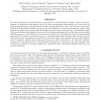Free Online Productivity Tools
i2Speak
i2Symbol
i2OCR
iTex2Img
iWeb2Print
iWeb2Shot
i2Type
iPdf2Split
iPdf2Merge
i2Bopomofo
i2Arabic
i2Style
i2Image
i2PDF
iLatex2Rtf
Sci2ools
96
Voted
HVEI
2009
2009
Improved colour to greyscale via integrability correction
The classical approach to converting colour to greyscale is to code the luminance signal as a grey value image. However, the problem with this approach is that the detail at equiluminant edges vanishes, and in the worst case the greyscale reproduction of an equiluminant image is a single uniform grey value. The solution to this problem, adopted by all algorithms in the field, is to try to code colour difference (or contrast) in the greyscale image. In this paper we reconsider the Socolinsky and Wolff algorithm for colour to greyscale conversion. This algorithm, which is the most mathematically elegant, often scores well in preference experiments but can introduce artefacts which spoil the appearance of the final image. These artefacts are intrinsic to the method and stem from the underlying approach which computes a greyscale image by a) calculating approximate luminance-type derivatives for the colour image and b) re-integrating these to obtain a greyscale image. Unfortunately, the s...
Related Content
| Added | 18 Feb 2011 |
| Updated | 18 Feb 2011 |
| Type | Journal |
| Year | 2009 |
| Where | HVEI |
| Authors | Mark S. Drew, David Connah, Graham D. Finlayson, Marina Bloj |
Comments (0)

